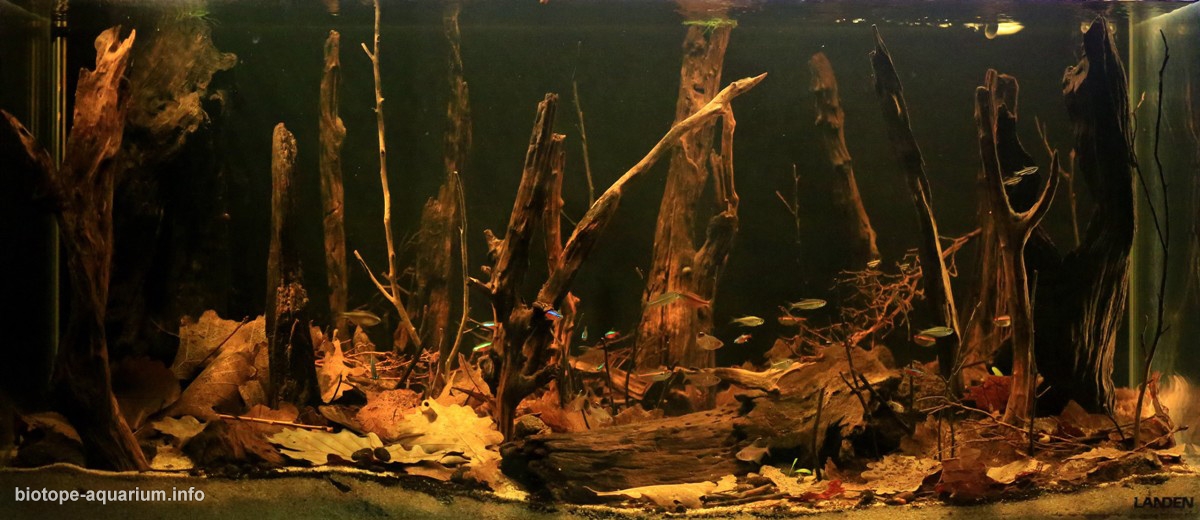Stream near Rio Demini, Amazonas, Brazil
96th place in Biotope Aquarium Design Contest 2019
China. Zhenhua Sun

Volume: 194 L
Dimensions: 100x45x45 cm
List of fishes: Paracheirodon axelrodi, Paracheirodon axelrodi var.,Nannostomus marginatus, Hyphessobrycon paepkei, Hyphessobrycon sp., Hyphessobrycon sp. var., Apistogramma bitaeniata, Hyphessobrycon amapaensis, Hyphessobrycon notidanos. (Here I would like to apologize for the inappropriate existence of Hyphessobrycon amapaensis and Hyphessobrycon notidanos in my aquarium, which are not native to the biotope I tried to recreate. I am a tetra fan and I try to collect those species I admire, yet some of the species are not naturally distributed in the same biotope. Hyphessobrycon amapaensis is native to Amapa in Brazil while Hyphessobrycon notidanos is native to Tabajos basin. I planned to take them out before I took pictures, but I gave this thought up as I didn’t want to interrupt their comfortable life in this water and cause panic among other fishes.)
List of plants: a small amount of moss on top of the wood stretching out of water
Description of decorations: I used bags of small volcanic rocks as the bed of this aquarium, above which, I covered with white and beige river sand. In order to simulate the blackwater environment, I used oak tree leaves and alder cones as riverbed substrate, as well as some broken twigs. In addition, I laid a thin layer of peat between the tree leaves and sand. I picked some straight woods with branches to replicate shorter submerged trees while thick bare trunks as chopped trunks. Dry twigs laid at the bottom vertically are mimics of new plants just sprout but drowned by the flood. Decayed tree leaves and gaps between large woods at the bottom provide perfect foods and shelters for dwarf cichlids.
Description of equipment: one Eheim 2275 canister filter, LED 10W*2 4500K with dimming function to avoid sudden lighting up and shutting down
Water parameters: pH 6.4, gH 3, temp. 25℃
Additional info: –
INFORMATION ABOUT BIOTOPE
Description of the area surrounding the biotope: Demini river is a river in the Amazon rainforest of the state of Amazonas, Brazil. It is a northern tributary of the Rio Negro and joins the latter near Barcelos,. The Demini River is originated in the Serra do Araca State Park, with an area of approx. 1,820,000 hectares of catchment. As one major tributary of Rio Negro, Rio Demini has a lot of slow streams flowing through the rainforest. The whole catchment in both Rio Negro and Rio Demini is covered by thick vegetation, which makes the color of water brownish due to fallen tree leaves.
Description of the underwater landscape of the biotope: The rivers and tributaries in the Negro basin are famous for the brownish coloration. Fallen leaves of vegetations along the rivers, tributaries and streams pile on the riverbed, which may reach as deep as more than 1 meter. Tannis and humics released out of the decomposed leaves turn the water into a color as strong tea (known as blackwater) and a low pH value. Due to the dark color, aquatic plants can be hardly found in these rivers and streams, making the water relatively poor in nutrition. In rainy season, excessive rainwater floods into the woods, submerging tree roots, tall arbor trunks and other shorter plants. Large area of water sometimes makes several smaller adjacent streams a larger interconnected flood pond. Aquarium creatures, such tetras, dwarf cichlids, etc., prey on small planktons, insects, insect larvae, decayed leaves and fruits falling in the water. Thick tree leaves, dense tree trunks and fallen branches provide perfect shelters for them. There is also a unique form of tetra living in the blackwater rivers, which are covered by a shining silver coat on their scales (their Latin names are usually followed by the suffix var.). They usually exist in a very small amount but many species have this unique mutation. Most of them are quite rare.
Description of the parameters of the habitat: There are significant differences in terms of water parameters in dry season and rainy season. In dry season (summer months in north hemisphere), due to the lack of rain water and heating weather, the water temperature can reach above 28℃ and pH would decrease to an extremely low level (around 4) since evaporation is much more than water supply. Meanwhile, the GH would rise as well. In rainy season, pouring rain water submerges the rainforest and dilutes the water ponds formed in dry season, which would rise the pH value to around 6.5. Rainwater is extremely soft and with very low conductivity and, lower temperature as well. These changes in water parameters stimulates fishes to swim around and spawn.
List of fishes and invertebrates occurring in the nature biotope: Paracheirodon axelrodi, Nannostomus marginatus, Hyphessobrycon paepkei, Hyphessobrycon sp., Apistogramma sp., Pseudacanthicus cf., Cichla ocellaris
List of plants found in the nature biotope: No aquatic plants except for flooded plants on land. Some parasite moss could be found on tree trunks due to the high humidity.
Threats to the ecology: Deforestation (lumbering, burning down…) is a severe threat to native ecosystem. Such changes in the jungle could bury small streams, possibly cause extinction to some native species no matter aquatic or terrestrial or amphibious, re-route some sections of the river and pollute the water. Such impact on the environment will not only damage native ecosystem and change local climate. If we do nothing to save the jungle, more and more precious creatures will go extinction even some of them are never found and revealed before. What’s worse, these negative effects will finally cause impacts on ourselves.
Sources of information:
https://books.google.com/books/about/The_Physical_Geography_of_Brazil.html?id=dZOFDwAAQBAJ
http://www.aquapress-bleher.com/alto-arac/
https://www.fishbase.se/summary/67526
